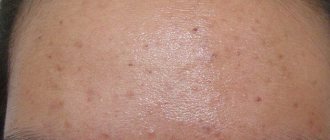The article was prepared by a specialist for informational purposes only. We urge you not to self-medicate. When the first symptoms appear, consult a doctor.
Fat formation under the skin of the scalp can not only become a serious cosmetic problem, but also lead to the development of inflammation as a result, for example, of injury from a comb. The size of a wen on the head varies from a few millimeters to 5-6 cm in diameter, and such a large tumor cannot be hidden under hair. The treatment of this pathology should be entrusted to a dermatologist or surgeon; you should not try to get rid of a wen on the head on your own, because this risks infection of the wound, incomplete removal and subsequent increase in the formation to an even more impressive size. In addition, any tumor needs careful diagnosis, since the symptoms of a wen may hide another, much more dangerous disease.
Symptoms of a wen on the head
The scalp, back of the head, area behind the ears, and facial skin are areas of the body rich in sebaceous glands. For various reasons, their secretion does not find a way out, the excretory duct becomes clogged, and fat begins to accumulate inside. This is how atheroma develops - a sebaceous gland cyst. It is this pathology that is usually meant by the phrase “fat on the head.”
Atheroma is a bulge of a regular round shape, rising above the surface of the skin. Most often, it does not change its color unless an infection gets into the capsule. Sometimes the contents of the wen are visible through the upper layer of the epidermis, the formation acquires a white or intense yellow tint. On palpation, the atheroma is elastic and painless; it can move to the sides and roll under the skin.
There is another common pathology called lipoma. This is a benign tumor consisting of fat cells enclosed in a connective tissue capsule.
It is quite difficult to differentiate a lipoma from an atheroma on the head, but still these wen have some obvious differences:
- Lipoma is usually localized deeper than atheroma, so its contents do not show through;
- Lipoma looks like a round or oval mound above the surface of the head, while atheroma looks more like a ball rolling under the skin;
- Lipoma has a softer and looser consistency, while atheroma is dense and elastic to the touch;
- The skin over the surface of a large lipoma can be gathered into a fold, which is completely impossible in the case of atheroma;
- A lipoma on the head can reach the size of an orange, while atheroma rarely grows to more than 3-4 centimeters in diameter.
Both types of wen on the head do not pose a great danger to health. If a lipoma or atheroma is diagnosed in a small child, and the formation does not cause discomfort and is not prone to rapid growth, it is recommended to wait until the patient reaches the age of seven in order to be able to remove the wen without general anesthesia and the associated risks.
What to do if it festers and bursts on its own?
So, if the capsule of the wen accidentally ruptures, a specific substance, similar in consistency to a thick cream, immediately flows out of it. Minor bleeding is also possible due to damage to the capillaries in the skin. When faced with such symptoms, you must:
- Use a napkin and carefully remove the discharge.
- Wipe the skin with any non-aggressive antiseptic. An excellent find could be inexpensive Chlorhexidine or the familiar hydrogen peroxide. Alcohol and iodine should not be used, as this can cause a burn, and the coloring components of iodine will subsequently prevent the doctor from adequately assessing the condition of the wound.
- Afterwards, you can apply Levomekol ointment to the skin, cover it with a cotton sponge or a medical napkin and secure this structure with a band-aid. This simple recommendation will help avoid the spread of the inflammatory process and prevent pathogenic microorganisms from entering the wound.
- In the absence of Levomekol, the use of a regular sterile gauze bandage is allowed.
Reasons for the formation of a wen on the head
Excessive sebum production in combination with improper care and injury to the epidermis leads to blockage of the sebaceous gland duct on the scalp. Typically, atheromas on the head occur in people who simultaneously suffer from oily seborrhea, dandruff or hyperhidrosis. There may be several reasons for this, ranging from hereditary predisposition to hormonal imbalance.
As for lipoma, everything is much more complicated here - such a benign tumor often has an unclear etiology. The leading factor, according to modern scientists, is the congenital deficiency of the enzyme TAG lipase, which is responsible for extracting energy and water from lipids accumulating in adipocytes. So, it doesn't matter how much lipid is in a particular person's fat cells - what matters is that those lipids are not broken down correctly. This is why lipomas on the head or other parts of the body often occur in thin people.
Additional reasons for the formation of wen:
- Hormonal disorders caused by endocrine pathologies (hypothyroidism, diabetes mellitus) or occurring against the background of age-related changes (pubertation, pregnancy, menopause);
- Liver and kidney failure, diseases of the gastrointestinal tract, leading to metabolic failures;
- Poor nutrition, unfavorable environmental conditions, bad habits.
Fatty formations on the head can be single or multiple. In the latter case, we are talking about lipomatosis, a systemic disease of hereditary nature.
Which doctor should I contact if I have ruptured?
When a lipoma suddenly ruptures, a surgeon most often comes to the rescue. But, in principle, the necessary assistance to the patient can also be provided by:
- Dermatologist.
- Cosmetologist with medical education.
Doctors strongly recommend contacting a clinic even before the rupture of the wen, at the moment when it begins to suddenly increase in size, causing redness of the skin, swelling and pain. But even if the tumor is in no hurry to become inflamed, but is located in a rather inconvenient place, it is better to consult a dermatologist before any problems arise.
If you have a burst wen, you can contact emergency room specialists at any time of the day. In case of severe inflammation, it is better not to hesitate and not wait until the morning (or the start of the working day), because only competent medical care will help to avoid extremely serious health consequences.
Is there a danger to life and health?
Very rarely, the wen undergoes malignancy, that is, atypical cells appear in its structure, and liposarcoma develops. To eliminate such a danger, you should undergo a full cycle of examination by a dermato-oncologist. The doctor may prescribe a cytological analysis, ultrasound, or taking part of the tumor for a biopsy. Diagnostics will help you choose the optimal treatment method and exclude other types of pathology with similar symptoms.
The tissues of the head are rich in blood vessels, and the treatment of any pathology localized here should be treated with special attention. At the first symptoms of trouble, you should seek medical advice. Self-removal of a wen on the head is dangerous because there is always a risk of infection and spread.
Prognosis and complications
Lipomas and atheromas are considered benign neoplasms that are not life-threatening. They do not spread to other organs and systems. But if they are not treated, the wen will grow and removal will lead to the appearance of scars. There are no relapses after surgical elimination.
Sometimes inflammation begins in the removal area. Seeing a doctor is mandatory, especially if you experience symptoms of infection. Infections can be easily treated with a course of antibiotics, but can be life-threatening if left untreated.
The neoplasm can be intracranial or intraosseous. Neglect of precautions during elimination leads to leakage of cerebrospinal fluid and complications - meningitis, death. Initial CT and MRI examination is used in the following cases:
- the tumor appeared at birth or at an early age;
- the presence of sounds, pulsations, changes in size during tension and crying;
- the formation connects with the surrounding tissues and has a liquid consistency;
- the tumor is located along the line of the nose, forehead, middle part of the head;
- the hairline is different;
- there have been previous head injuries and surgical operations;
- hereditary predisposition to meningitis, neurological pathologies.
Lipomas inside the skull are rare, benign, congenital and slow-growing tumors of the nervous system.
Treatment of wen on the head
Wen on the scalp almost always tends to gradually increase in size. Consequently, the risk of pressure from its capsule on surrounding tissues, vessels and nerve endings increases. In addition, such education looks very unattractive from an aesthetic point of view. Therefore, patients with wen on the head strive to get rid of them using modern methods.
Just a few decades ago, the main method of treating lipomas was their surgical excision under general or local anesthesia. This intervention left noticeable scars and scars on the scalp. At the present stage of development of medicine, more gentle and effective methods for removing lipid formations on the head have been developed. A prerequisite for successful intervention is careful peeling of the capsule in which fat accumulates. If connective tissue cells remain, the risk of relapse increases significantly.
Treatment methods:
- Traditional surgical intervention - used in the case of large fatty tumors, including those that have become infected and inflamed;
- Introduction into the cavity of the formation of a special substance that dissolves fats - used to treat small non-inflamed wen;
- Liposuction is pumping out sebaceous secretions with a special lipoaspirator; when using this method there is a risk of relapse;
- Radio wave enucleation - removal of a wen on the head using a radio knife; the procedure takes a minimum of time and does not cause complications or relapses;
- Laser removal - excision of the wen using a narrowly directed laser beam, while the vessels are coagulated, no scars are left, and the wen does not develop again.
The contents of the wen capsule are sent for histological examination to determine the presence or absence of atypical cells. The postoperative period is under the supervision of a doctor to prevent wound infection and takes about ten days.
When can a lipoma burst?
Benign wen are considered relatively safe, but when exposed to certain negative factors, they can suddenly increase in size, become inflamed and fester. This development of events is accompanied by:
- Noticeable changes in the skin (visible redness), as well as an increase in its temperature.
- Pain that is constantly present and intensifies in response to palpation.
Inflammation of the wen may not be accompanied by suppuration. This condition can develop and pass without particularly disturbing a person’s well-being. But with each subsequent inflammation, the risk of suppuration and rupture of the wen will increase.
It is believed that the inflammatory process in the lipoma and its subsequent rupture can occur as a result of:
- Constant mechanical impact (in particular, squeezing or scratching).
- Injury after a blow or fall.
- Wearing tight clothes.
It is worth considering that a burst wen is not just an annoying nuisance. This phenomenon should be considered as a significant reason for urgently seeking medical help.
Relapse Prevention
To prevent wen on the head from appearing again, you need to try to eliminate the factors that cause increased secretion of sebum. To do this, you need to follow the rules of personal hygiene, use high-quality cosmetics to care for your face and hair, but not over-wash your hair - the more often we do this, the more actively the sebaceous glands work, trying to compensate for dryness in this way. You should comb your hair as carefully as possible so as not to damage the epidermis. And remember that the first symptoms of a suspicious tumor or lump on the head are a reason to immediately consult a doctor. Early diagnosis and treatment will allow you to correctly differentiate the pathology and eliminate the wen without scars.
Author of the article:
Volkov Dmitry Sergeevich |
Ph.D. surgeon, phlebologist Education: Moscow State Medical and Dental University (1996). In 2003, he received a diploma from the educational and scientific medical center for the administration of the President of the Russian Federation. Our authors
Therapy
Treatment is prescribed after all necessary tests have been carried out. If a malignant tumor is present, therapy is prescribed by an oncologist. Begin to remove the wen using the following methods:
Lipoma injection
- Medicines. A medication is injected into a dense tumor, which accelerates the process of resorption of adipose tissue. The fibroid shrinks in size. For deep lumps, repeat treatment with an injection; the formation should disappear after two months. In the initial stage of wen formation, it is worth using ointments with absorbable and antiseptic properties. To treat suppuration in atheroma, the doctor prescribes antibiotics, tablets or injections.
- Laser exposure. Wen removal is performed using laser beams that remove the tumor without damaging healthy areas of the scalp. The tissue is destroyed quickly, which eliminates the need for anesthesia. Suitable for small and medium sizes, does not leave marks or scars.
- Endoscopy. During the operation, the doctor can remove the formation and examine its structure. It is carried out using a device that is inserted into a small subcutaneous incision near the lipoma. The method is considered effective and occurs with the least damage to the skin.
- Excision. The membrane with fat content is cut out from under the skin, while part of the dermis with the sebaceous duct is excised, the wound is treated and sutured. After surgery, scars remain. A large wen needs to be cut out; other methods of therapy are considered ineffective.
- Liposuction - the contents of the fatty membrane on the head are pumped out through a puncture and the introduction of a thinning medication inside. The method allows you to quickly eliminate the problematic formation, but after it the lipoma on the head appears again.
In cases of inflammation and the appearance of purulent masses, surgery is performed urgently, preventing the membrane from tearing and pus spreading under the skin.
Preventive actions and use of folk remedies
To avoid surgical intervention, you can try to improve the functioning of metabolic processes at home. Water with the addition of lemon juice can help the body remove toxic accumulations. This method activates the activity of the liver and kidneys.
Products with added preservatives, chemical additives and high fat content are excluded from the diet. It is advisable to add nuts, fish and sesame to the menu. By changing your diet, there is a chance to cure lipomas, but this will take a long time.
Therapy with traditional methods will help lead to the elimination of the wen. You just need to do this after consulting a doctor. Effective methods include the use of warm castor oil, apple cider vinegar, butter and green tea. These products are applied to the formation, promote the resorption of the wen, and reduce inflammation.
If during treatment the tumor in the hair becomes inflamed and hurts, you should immediately visit a specialist. Home remedies will help reduce the size of the lipoma, but they do not remove the capsular membrane completely, leading to the recurrence of the disease.
For prevention, you should avoid injuries and damage to the skin, and regularly do genetic tests if there is a hereditary predisposition.
What factors contribute to the development of wen
The causes are varied. More than 50% of cases are a genetic predisposition. There is even such a thing as “familial lipomatosis.”
The content of the article
- What factors contribute to the development of wen
- Symptoms and diagnosis of lumps
- Medical possibility of deliverance
- Folk remedies
Main reasons:
- excess weight;
- hormonal disorders;
- pathology of the sebaceous glands;
- metabolic disease;
- intestinal slagging;
- vegetative-vascular dystonia;
- chronic gastrointestinal diseases;
- kidney and liver damage.
Possible consequences
Lipoma is a benign tumor, but large, old tumors sometimes become malignant liposarcoma. Particularly dangerous is myelolipoma, which affects blood vessels with adipose tissue, which disrupts the functionality of various organs.
If the wen is opened inside the body, then a severe threat arises. Leaking purulent contents in contact with tissue structures are dangerous due to the following complications:
- Increased temperature .
- Development of the inflammatory process.
- Formation of bleeding ulcers.
- death .
- Cutting off the affected area of the body.
When a tumor is opened, the risk of pathology spreading throughout the body increases. The resulting lipomatosis replaces normal cells with fat and changes the structure of internal organs.
To avoid dangerous consequences, you should not wait for to break through , but rather visit a specialist who will prescribe effective treatment. If removal is delayed, it is recommended to protect the lipoma from external irritants. Squeezing out on your own will only complicate the situation.
Symptoms of brain lipoma
The list of symptoms that a tumor manifests itself is greatly influenced by the type of lipoma, its location and size. Among the main signs of a neoplasm:
- Frequent attacks of dizziness.
- Cramps.
- Loss of consciousness.
- Hallucinations – both visual and auditory.
- Memory impairment.
- Decreased ability to concentrate.
- Speech disorders.
All these are early signs of lipoma. They say that the tumor has begun to grow, but has not yet become large enough to greatly affect the brain.
At later stages of the disease, other disorders occur. They are caused by an increase in intracranial pressure. The most common:
- Severe convulsive seizures.
- Loss of sensation in different parts of the body.
- Attacks of apathy, depression.
- Sleep disorders.
- Tremor of the limbs.
- Increased sweating.
- Instability of appetite.
Many patients have movement disorders. They cannot move normally, coordination becomes significantly worse. With a strong increase in intracranial pressure, the risk of paralysis and paresis is high.
As you can see, the list of symptoms is very extensive. This complicates the work of doctors - often the signs of lipoma are confused with other diseases. An MRI of the brain is becoming the most effective means of searching for a tumor and assessing its current condition.










